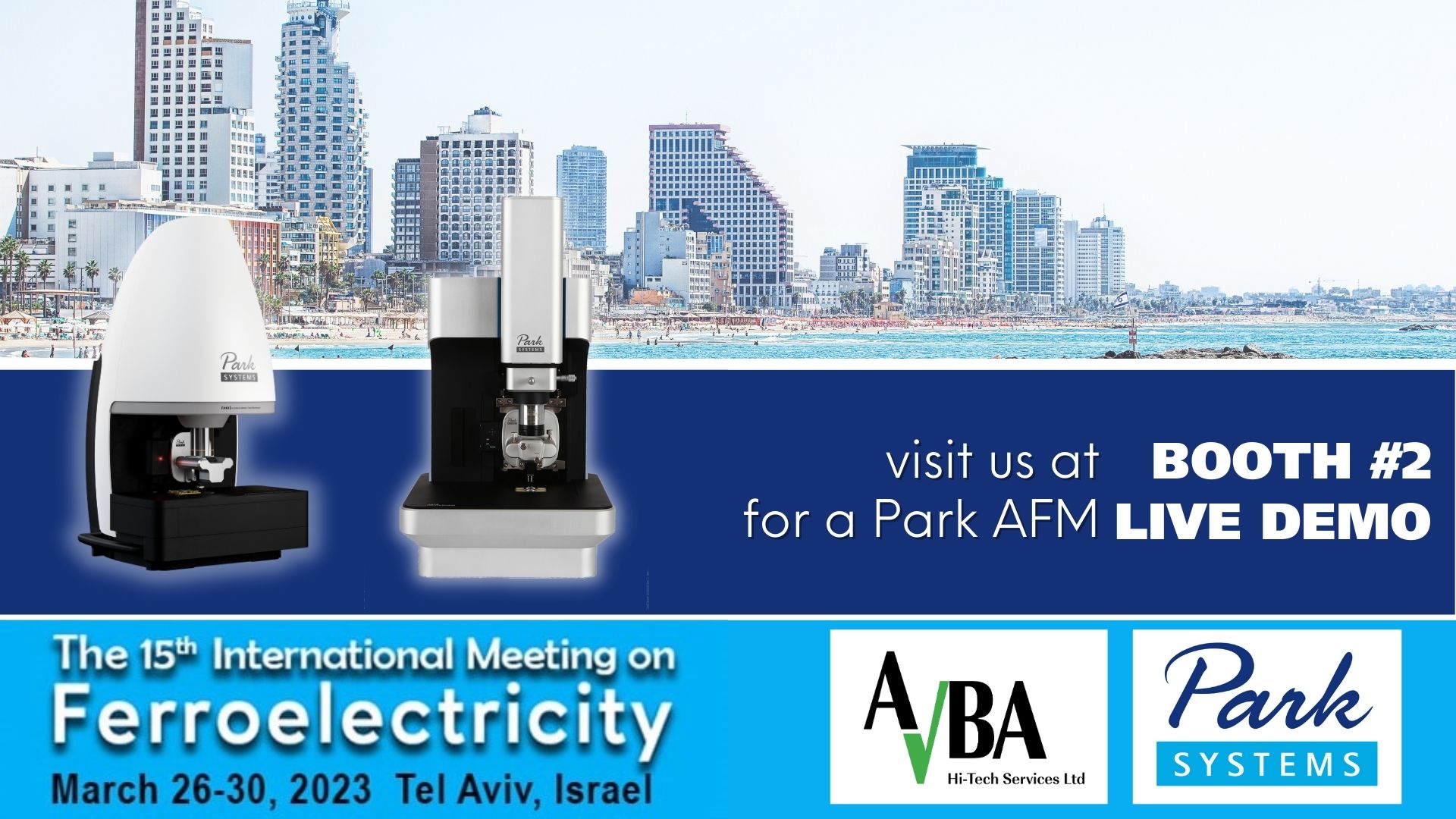
For the first time AVBA and Park Systems Europe will join forces to participate at the 15th International Meeting on Ferroelectricity (IMF) from 26-30 March 2023 at the Dan Panorama Hotel in Tel Aviv, Israel.
Join our booth #2 for a live demonstration of the Park NX10 AFM, high-resolution atomic force microscope for materials research, with unique features such as the Non-Contact mode for non-destructive nanoimaging, and flexure based independent XY and Z scanner for unparalleled accuracy and resolution.
Don’t wait and book a demo slot today: pse@parksystems.com
_______________________________________________________________________________________________________________________

Join Dr. James Kerfoot, Application Scientist at Park Systems United Kingdom at IMF2023 for his talk:
- ⏩ TALK: “Mapping tunnelling currents across switchable ferroelectric domains in parallel stacked layered materials with atomic force microscopy”
- ⏩ DATE: Thursday, March 30, 9.15 – 9.30 am, at Hall C
- ⏩ BOOTH No.: 2
ABSTRACT
Presenting Author: Dr. James Kerfoot1
Co-Author: Dr. Vladimir Korolkov 1
1Park Systems UK Ltd, MediCity Nottingham, D6 Thane Rd, Nottingham, UK, NG90 6BH
Among all state-of-the-art characterisation techniques, atomic force microscopy (AFM) is particularly powerful tool in the study of layered materials since it can be used to measure both atomic registry of such layered materials heterostructures and their associated functional properties at sub-nanometre length scales. In this talk, we use electrostatic force microscopy (EFM), Kelvin probe force microscopy (KPFM) and conductive AFM (CAFM) to study the morphology and manipulation of ferroelectric superlattices in marginally twisted hexagonal boron nitride and molybdenum disulphide.

Controlling the twist angle between flakes of layered materials leads to interfacial ferroelectricity in the case of parallel stacked hexagonal boron nitride (hBN) [1-3]. We provide an account of the fabrication of such parallel stacked hBN samples using a home-built transfer setup [4] and the mapping of ferroelectric domains using various scanning probe techniques. We then discuss different ways in which such domains may be mapped and manipulated both electrically and mechanically [3,5]. In particular, we utilise CAFM (where a tunnelling current is measured across a bilayer of parallel stacked hBN) to systematically study the variation of domain morphology versus mechanical setpoint and tip-sample bias.
We show electrostatically induced switching of the registry of layers, enabling elevated relative areal coverage of AB domains versus BA domains depending upon the magnitude and direction of the applied bias. By performing conductive atomic force microscopy on parallel stacked hBN bilayers on graphene, we simultaneously map and manipulate the superlattice morphology to gain insights into both the mechanics of domain switching and tunnelling mechanisms under the influence of interfacial ferroelectricity. Such measurements are the nanoscale analogue of memristive tunnel diodes formed from parallel stacked hBN, which offer functionalities desirable for ‘more than Moore’ electronic devices.
References
[1] C. R. Woods et al. Nat Commun. 12, 347 (2021).
[2] K. Yasuda et al. Science 372, 6549 1458 (2021)
[3] M. Vizner Stern et al. Science 372, 6549, 1462, (2021)
[4] Q. Zhao et al. J. Phys. Mater. 3 016001 (2020
[5] O. Kolosov et al. Phys. Rev. Lett. 74, 4309 (1995)
_______________________________________________________________________________________________________________________
About IMF:
The International Meeting on Ferroelectricity (IMF) is the longest-running home for the vibrant research community of ferroelectricity. The IMF covers the broad field of ferroelectricity from basics and theory through material behavior, and processing to applications. With the rapid pace of outstanding discoveries and world-changing inventions, it is hard to believe that the first IMF was in 1966.
Link: https://imf2021.org/
